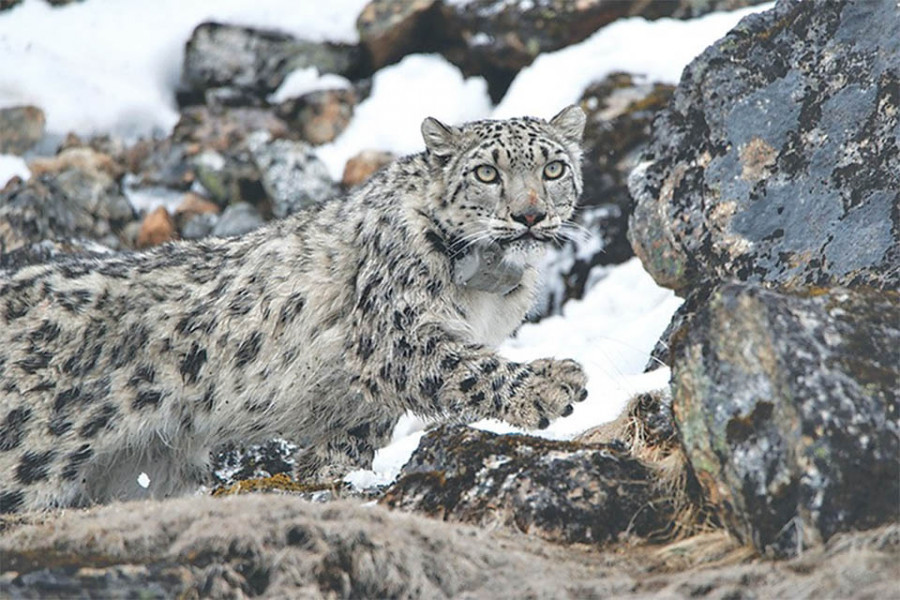Climate & Environment
Retaliatory killings major challenge for snow leopard conservation
As the country celebrates International Snow Leopard Day, experts recount challenges faced by the mountain cat.
Chandan Kumar Mandal
Local communities kill snow leopards that prey on their livestock, and this is one of the major challenges to saving the elusive mountain cat, according to conservationists.
On International Snow Leopard day conservationists are worried that the apex predator of the Himalayan ecosystem also faces a plethora of challenges due to human activities near their habitats.
According to Gopal Khanal, a snow leopard researcher, retaliatory killing of the cats by local communities is the most prominent threat they face.
“There are several other threats such as climate change, habitat loss, lack of reliable data on its status and population, and wrong perception of people. But the biggest threat is killing by local communities for the damages caused by these predators,” said Khanal, also the assistant conservation officer with the Shey Phoksundo National Park. “In addition to that, decline in prey population has emerged as other threats. In some areas, locals even kill animals that snow leopards feed on because they damage the crops.”
Khanal’s recently published study showed that snow leopards from Upper Dolpa and Lower Dolpa turn to domesticated animals despite the abundance of wild prey in their habitat. Such a situation can lead to the killing of snow leopards for livestock depredation.
Nepal government’s snow leopard conservation action plan (2017-2021) also identifies livestock depredation by snow leopards, and crop damage by prey species as the main cause of human-wildlife conflicts in the mountain region.
Another snow leopard researcher Kamal Thapa also acknowledges retaliatory killing of snow leopards as the major threat to conservation efforts aimed at saving the animal , listed as “vulnerable” in the IUCN Red List of Threatened Species.
Thapa, who was speaking at an interaction organised by Environmental Graduates in Himalaya and Resources Himalaya Foundation to mark the International Snow Leopard Day (Oct 23), said 33 percent of snow leopards’ diet comes from domesticated animals, and 67 from wild prey, mainly blue sheep, and Himalayan tahr among others.
“Snow leopards have eaten horses which are highly valuable in the mountain region. In 2003-04, snow leopards killed nearly 40 goats and sheep in one shed,” said Thapa, who has been studying snow leopards since 1999. “All this depredation indicates the level of potential human-wildlife conflict..”
Snow leopards are found in 12 countries, including Nepal, across the Himalayas and high mountains of Central Asia. Fewer than 4,000 adult snow leopards are believed to be alive in the wild as they continue to face threats due to habitat loss, poaching and climate change. It is estimated that Nepal is home to around 300-400 individuals.
Snow leopards are found within and outside mountain protected areas of Nepal where their habitat is broadly arranged into three large snow leopard conservation landscapes: eastern, central, and western.
The eastern landscape extends from Kangchenjunga Conservation Area to Langtang National Park (LNP). The central landscape spreads from LNP (west) to Tscharka Pass near the western fringe of Annapurna Conservation Area.
The western landscape–the largest in terms of area— is home to the largest population of snow leopards in Nepal as it extends from Tscharka pass to Api-Nampa Conservation Area in the far-western part of the country, and includes Dhorpatan Hunting Reserve (DHR), Shey Phoksundo National Park (SPNP), Rara National Park and Khaptad National Park, according to the action plan.
Potential snow leopard habitat is estimated to be an area of 13,000 sq km in Nepal.
According to Khanal, nearly 30 percent of snow leopard habitats are outside protected areas
“Besides, human development aspirations have affected snow leopard habitat. Ongoing construction in and around snow leopard habitats has emerged as a challenge,” said Khanal. “As many as ten of the 13 north-south corridors go past snow leopard habitats, disturbing their ecology and natural habitat.”
Thapa thinks the government also needs to reconsider its existing conservation model for sustainable conservation of snow leopards.
“Mountainous people share their habitat with snow leopards. They are in conflicts with the animals, but they are still surviving together,” said Thapa. “For their coexistence and promotion of sustainable conservation, these people should also be given rights, not only responsibilities.”




 20.12°C Kathmandu
20.12°C Kathmandu











